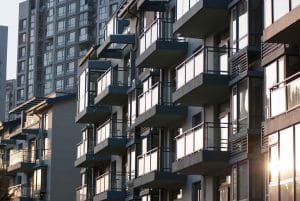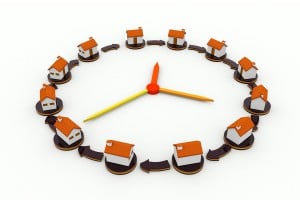What’s a better investment in today’s market - apartments or houses?
That’s the topic of today’s show.
Now I could give you a simple answer, but I thought it was better to help you understand the thought process behind my decision than give you an immediate answer.
Of course, I’ll also be sharing my mindset message for today before the end of the show.
So is it better to invest in a house or an apartment?
The change to a new working and home life prompted by the COVID-19 pandemic, combined with a loss of confidence thanks to some shoddy high-rise apartment buildings during the last building boom has seen investors increasingly shy away from investing in apartments.
It seems that more investors are now asking if apartments are still a good investment in the current market.
Well… my response is… it depends.
I remember times when apartments outperformed houses, but for the last decade or so house values have risen at more than twice the rate of units.
And the current property boom widened what was already a sizeable difference in prices.
Of course, historically apartments have been cheaper than houses but the gap in prices has grown particularly wide in the past year.
Some apartments, especially family-friendly low-rise apartments in lifestyle neighborhoods have still performed well and are likely to remain in continuous strong demand.
The Numbers of Apartment Living
The 2016 Census of Population and Housing found that 10% (2,348,434) of all people in Australia spent Census night in an apartment.
This meant that there was around one occupied apartment for every five occupied houses in Australia - compared with one to every seven, back in 1991.
While the number of vacant rental listings has fallen significantly in Brisbane, Darwin, Perth, Adelaide, and Hobart over the past year, Sydney and Melbourne continue to bear the brunt of closed international borders that has left many inner-city apartments without tenants.
Data from Domain showed Melbourne’s vacancy rate sat at 4.7 percent as of February 2021 — a massive spike from the same time last year when the vacancy rate was 1.6 percent.
Choosing the right neighborhood
Sure, last year offices were shut and lockdowns were in place but moving forward more of us are likely to continue working flexible rosters and working at home more than ever.
This means gone are the days where our ‘home’ was simply the place we rest our heads and enjoy some downtime between work and our social lives – the coronavirus crisis has put an end to life as we once knew it.
If you can leave your home and be in short 20-minute proximity – whether that is on public transport, bike ride or walk - to a great shopping strip, your favorite coffee shop, amenities, the beach, a great park, that’s the new gold standard of where people want to live.
What matters in a home?
And it’s not just the importance of neighborhood that has shifted Australians’ views.
The legacy of the lockdowns and the work-from-home-movement have made many Australians reevaluate what exactly they want in the home itself.
All of a sudden people were trying to find space to be able to work, study, and also relax all under one roof - and in many cases, this hasn’t gone well.
Prior to COVID-19 more Australians were trading space for place and were embracing apartment living, trading their backyards for balconies and courtyards in inner-city locations.
Now we want more space – a zoom room, a bigger yard, and a garage that can be converted to a gym.
High rise apartments: The slums of the future
It’s worth pointing out that while large well-located suburban medium-density apartments will make great investments increased substantially in value over the long term, many of the high-rise towers built in the last fifteen years will continue to underperform with poor, if any, capital growth in the foreseeable future.
Of course, these cookie-cutter-style apartment blocks never made good investments.
The sad reality is that today, in light of the many media reports of structural problems in some of these high-rise towers, there is a crisis of confidence.
This sector of the property market has lost the trust of the buying public and confidence will take quite some time to restore as various stakeholders including state and local governments as well as the construction industry including building surveyors and certifiers scramble to shore up the building sector.
Investors are shying away
Historically, a significant volume of apartments were bought by local and overseas investors.
But as I explained, now many of these investors are shying away from apartments, due to increasing concerns about vacancy rates, capital growth, and also because of COVID-19 related concerns.
Highly-publicized failures and defects in high-rise apartments, such as the Opal Tower in Sydney, are also playing their part and dampening demand.
But it’s important for investors to remember that not all apartments can be lumped into the same category.
While many new homes are being constructed, the pipeline for new apartment complexes is very thin meaning when our borders eventually reopen and demand for apartments increases from the many new migrants and students returning to Australia, apartment prices will start increasing again as the cost of constructing new projects will be considerably higher than previous building costs.
This will of course push up the price of new apartments and with it drag up the price of established apartments.
Remember, property markets are cyclical
In the short run, returns can be inconsistent, but it’s well documented that investment returns eventually revert to their long-term averages.
That is, periods of below-average growth tend to be followed by periods of above-average growth and vice versa
While houses outperformed apartments with regard to capital growth over the last decade, for the 10 years prior to that many well-located apartments grew in value as much as houses did.
The fact the houses have displayed strong capital growth rates over the past 10 years due to appreciating land values, interestingly implies that apartments are currently intrinsically undervalued.
But comparing apartments to houses is unfair
Of course, if your budget allows you to buy a house or townhouse in an A-grade location, that’s the first prize when considering an investment purchase, but our booming property markets mean that more and more investors will be unable to afford a house in an investment-grade location.
Fact is, the rich are getting richer and they don’t want to travel further out and I believe the gap between values in our established inner suburban locations and the outer suburbs will only widen.
Australia’s apartment market: The outlook
In the short term….
Over the next year or two, it is likely that there will be less demand for apartments while first home buyers continue to prioritize houses and investors remain wary.
In the long term….
Over the next 10 years, I think we’re going to see a shift in Australia’s apartment market and a much more substantial increase in capital growth.
Why?
While currently around 10% of our population living apartments, this is significantly lower than the percentage of people living in apartments in similar size western cities to Sydney and Melbourne, where it’s not unusual to find 20 to 30% of the population living in apartments.
Then, in light of structural and building problems in recent years, the next round of apartments will cost significantly more to build as builders and surveyors will be forced to avoid cutting corners and risking further scrutiny.
This will, in turn, push up new apartment prices and therefore values of well established apartments.
Resources:
Get the team at Metropole to help build your personal Strategic Property Plan Click here and have a chat with us
Get a range of my ebooks here: www.PodcastBonus.com.au
Some of our favorite quotes from the show:
“There’s not one property market, so we can’t even say there’s one apartment market.” – Michael Yardney
“These days, the place people want to be is not near the CBD, but in lifestyle neighborhoods where all the amenities are close by.” – Michael Yardney
“Watching a movie that excites you, inspires you, makes you laugh, takes you away to another place, that’s a good way of turning off your stress.” – Michael Yardney
PLEASE LEAVE US A REVIEW
Reviews are hugely important to me because they help new people discover this podcast. If you enjoyed listening to this episode, please leave a review on iTunes - it's your way of passing the message forward to others and saying thank you to me. Here's how
Subscribe & don’t miss a single episode of Michael Yardney’s podcast
Hear Michael & a select panel of guest experts discuss property investment, success & money related topics. Subscribe now, whether you're on an Apple or Android handset.
Need help listening to Michael Yardney’s podcast from your phone or tablet?
We have created easy to follow instructions for you whether you're on iPhone / iPad or an Android device.
Prefer to subscribe via email?
Join Michael Yardney's inner circle of daily subscribers and get into the head of Australia's best property investment advisor and a wide team of leading property researchers and commentators.

![[Podcast] What makes a better investment in today’s market – a house or an apartment?](https://cdn.propertyupdate.com.au/wp-content/uploads/2021/07/MY-podcast-272-Apartments-or-houses.jpg)









![What will life be like in a smaller Australia [video] Exploring the population rivalry: Melbourne vs. Sydney](https://cdn.propertyupdate.com.au/wp-content/uploads/2020/08/population-270x200.jpg)
![Sydney and Melbourne to triple in size? Sydney housing market update [video] | July 2024](https://cdn.propertyupdate.com.au/wp-content/uploads/2018/11/sydney4-270x200.jpg)


